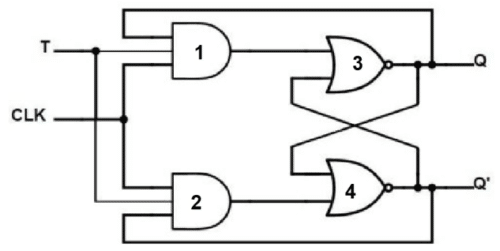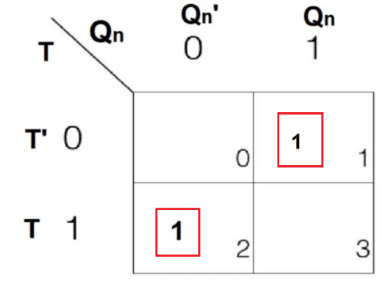T flip flop is similar to JK flip flop. Just tie both J and K inputs together to get a T Flip flop. Just like the D flip flop, it has only one external input along with a clock.

Also Read: Flip-Flop Basics
T Flip-Flop Working
Let us take a look at the possible cases and write it down in our truth table. The clock is always 1, so only two cases are possible where T can be high or low.
Case 1: T=0
Gate1 = 0, Gate2 = 0, Gate3/Q(n+1) = Q, Gate4/Q(n+1)’ = Q’
Note:
- Since one of the inputs to Gate1 and gate2 is 0 and both are AND gates; the output of gate1 and gate2 will be equal to 0 irrespective of other inputs as per the property of AND gates
- Gate3 = (0+Q’)’ = (Q’)’ = Q
- Gate4 = (0+Q)’ = (Q)’ = Q’
Case 2: T=1
Gate1 = Q, Gate2 = Q’, Gate4/Q(n+1)’ = 0, Gate3/Q(n+1) = Q’
Note:
- Since one input of both gate1 and gate2 is 0 and both gates are AND gates, the output of both gates will be equal to the third input.
- Gate4 = (Q’+Q)’ = 1’ = 0
- Gate3 = (Q+0)’ = Q’
Now let us write the truth table-
T Flip-Flop Truth Table
| CLK | T | Q(n+1) | State |
| 0 | Q | NO CHANGE | |
| 1 | Q’ | TOGGLE |
We will use this truth table to write the characteristics table for the T flip flop. In the truth table, you can see there is only one input T and one output Q(n+1). But in the characteristics table, you will see there are two inputs T and Qn, and one output Q(n+1).
From the logic diagram above it is clear that Qn and Qn’ are two complementary outputs that also act as inputs for Gate3 and Gate4 hence we will consider Qn i.e the present state of Flip flop as input and Q(n+1) i.e. the next state as output.
After writing the characteristic table, we will draw a 2-variable K-map to derive the characteristic equation.
| T | Qn | Q(n+1) |
| 0 | 0 | 0 |
| 0 | 1 | 1 |
| 1 | 0 | 1 |
| 1 | 1 | 0 |

From the K-map you get 2 pairs. On solving both we get the following characteristic equation:
Q(n+1) = TQn’ + T’Qn = T XOR Qn
T Flip Flop Advantages
There are several advantages to using a T flip flop. Some of them are listed below:
- Single input: The T flip-flop has a single input that can be used to toggle between two states, which makes it simpler to use and easier to interface with other digital circuits.
- No invalid states: The T flip-flop does not have any invalid states, which helps to avoid unpredictable behaviour in digital systems.
- Reduced power consumption: The T flip-flop consumes less power than other types of flip-flops, making it more energy efficient.
- Bi-stable operation: Like other flip-flops, the T flip-flop has a bi-stable operation, which means that it can hold a state indefinitely until it is changed by an input signal.
- Easy to implement: The T flip-flop can be easily implemented using simple logic gates, which makes it a cost-effective option for digital systems.
Limitations of T Flip Flop
Apart from several advantages, there are some limitations associated with T flip-flops. Some of them are listed below:
- Inverted output: The output of a T flip-flop is inverted from the input, which can be confusing and make it difficult to design sequential logic circuits.
- Limited functionality: The T flip-flop can only store a single bit of information and cannot perform more complex operations like addition or multiplication.
- Glitches: The T flip-flop is vulnerable to glitches and noise on the input signal, which can cause it to toggle unexpectedly and lead to unpredictable behaviour in digital systems.
- Propagation delay: Like other flip-flops, the T flip-flop has a propagation delay, which can lead to timing issues in digital systems with tight timing constraints.
Applications
Some of the applications of T flip flop in real-world includes:
- Frequency division: The T flip-flop can be used to divide the frequency of a clock signal by two, making it useful in applications such as digital clocks and frequency synthesizers.
- Frequency multiplication: The T flip-flop can also be used to multiply the frequency of a clock signal by two, making it useful in applications such as frequency synthesizers and digital signal processing.
- Data storage: The T flip-flop can be used to store a single bit of data, making it useful in applications such as shift registers and memory devices.
- Counters: The T flip-flop can be used in conjunction with other digital logic gates to create binary counters that can count up or down depending on the design. This makes them useful in real-time applications such as timers and clocks.







